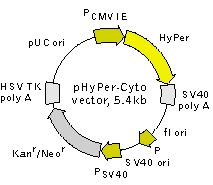
|
||||||||||
|
||||||||||

|
|
||||||||||||||||||||||||||||||||||||||||||||||||||||
The vector sequence has been compiled using the information from sequence databases, published literature, and other sources, together with partial sequences obtained by Evrogen. This vector has not been completely sequenced. |
|||||||||||||||||||||||||||||||||||||||||||||||||
 Download
|
| ||||||||||||||||||||||||||||||||||||||||||||||||
Vector description
pHyPer-cyto is a mammalian expression vector encoding a fluorescent sensor HyPer (see reporter description). To increase mRNA translation efficiency, Kozak consensus translation initiation site is generated upstream of the HyPer coding sequence [Kozak, 1987].
The vector can be also used as a source of HyPer coding sequence. Flanking restriction sites are convenient for excision of HyPer sequence and its further insertion into other expression vectors of choice. Alternatively, HyPer coding sequence can be amplified by PCR.
Note: The plasmid DNA was isolated from dam+-methylated
The vector backbone contains immediate early promoter of cytomegalovirus (PCMV IE) for protein expression, SV40 origin for replication in mammalian cells expressing SV40 T-antigen, pUC origin of replication for propagation in
SV40 early promoter (PSV40) provides neomycin resistance gene (Neor) expression to select stably transfected eukaryotic cells using G418. Bacterial promoter (P) provides kanamycin resistance gene expression (Kanr) in
Expression in mammalian cells
pHyPer-cyto vector can be transfected into mammalian cells by any known transfection method. CMV promoter provides strong, constitutive HyPer expression in eukaryotic cells. If required, stable transformants can be selected using G418 [Gorman, 1985].
Propagation in
Suitable host strains for propagation in
Location of features
PCMV IE: 1-589
Enhancer region: 59-465
TATA box: 554-560
Transcription start point: 583
HyPer
Kozak consensus translation initiation site: 596-606
Start codon (ATG): 603-605
Stop codon: 2037-2039
SV40 early mRNA polyadenylation signal
Polyadenylation signals: 2238-2243 & 2267-2272
mRNA 3' ends: 2276 & 2288
f1 single-strand DNA origin: 2335-2790
Bacterial promoter for expression of Kanr gene
-35 region: 2852-2857
-10 region: 2875-2880
Transcription start point: 2887
SV40 origin of replication: 3131-3266
SV40 early promoter
Enhancer (72-bp tandem repeats): 2964-3035 & 3036-3107
21-bp repeats: 3111-3131, 3132-3152 & 3154-3174
Early promoter element: 3187-3193
Major transcription start points: 3183, 3221, 3227 & 3232
Kanamycin/neomycin resistance gene
Neomycin phosphotransferase coding sequences:
Start codon (ATG): 3315-3317
Stop codon: 4107-4109
G->A mutation to remove Pst I site: 3497
C->A (Arg to Ser) mutation to remove BssH II site: 3843
Herpes simplex virus (HSV) thymidine kinase (TK) polyadenylation signal
Polyadenylation signals: 4345-4350 & 4358-4363
pUC plasmid replication origin: 4694-5337
References:
- Gorman C. High efficiency gene transfer into mammalian cells. In DNA cloning: A Practical Approach, Vol. II. Ed. D. M. Glover. (IRL Press, Oxford, U.K.). 1985; 143-90.
- Kozak M. An analysis of 5'-noncoding sequences from 699 vertebrate messenger RNAs. Nucleic Acids Res. 1987; 15 (20):8125-48. / pmid: 3313277
Notice to Purchaser:
HyPer-related materials (also referred to as "Products") are intended for research use only. Some elements of these materials may be covered by third party patents issued and applicable in certain countries. No license under these patents is conveyed expressly or by implication to the recipient of the materials. Users of these materials may be required to obtain a patent license depending upon the particular application and country in which the materials are received or used.
|
Copyright 2002-2023 Evrogen. All rights reserved. Evrogen JSC, 16/10 Miklukho-Maklaya str., Moscow, Russia, Tel +7(495)988-4084, Fax +7(495)988-4085, e-mail:evrogen@evrogen.com |


